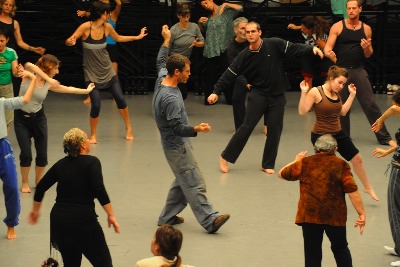Gaga: Ohad Naharin’s Movement Language, in His Own Words

(Photo: Gaga class in November 2008 led by Ohad Naharin, center. Photo by Gadi Dagon, courtesy of Yossi Naharin.)
While I love sharing my perspective in this blog, I also want artists’ voices to be heard on Dance In Israel. Sometimes you will literally hear dance professionals speak in my podcasts, while at other times I will quote them in writing.
I have already posted one article about Gaga, the movement language developed by Batsheva Dance Company’s artistic director Ohad Naharin. Given its significance in the dance world and my own interest in Gaga, I will feature more articles on this subject – but before I proceed with my experiences in Gaga, I want Ohad’s voice to take center stage. Ohad Naharin wrote the text below in March 2008, and it is here on Dance In Israel courtesy of Yossi Naharin.
* * *
“Gaga challenges multi layer tasks. It is fundamental for gaga users to be available for this challenge.
At once we, the users, can be involved in moving slowly through space while a quick action in our body is in progress. Those dynamics of movement are only a portion of what else might go on at the same time.
We are letting our mind observe and analyze many things at once, we are aware of the connection between effort and pleasure, we connect to the “sense of plenty of time”, especially when we move fast, we are aware of the distance between our body parts, we are aware of the friction between flesh and bones, we sense the weight of our body parts, we are aware of where we hold unnecessary tension, we let go only to bring life and efficient movement to where we let go…
We are listening, seeing, measuring, playing with the texture of our flesh, we might be silly, decorating our inside, we can laugh at ourselves.
We learn to love our sweat, we discover our passion to move and connect it to effort, we discover both the animal in us and the power of our imagination.
We learn to appreciate understatement and exaggeration, we discover the difference between joy and pleasure and use both to protect ourselves from injuring and hurting our body, we learn to apply our force in an efficient way and we learn to use “other” forces,
We become more delicate and we recognize the importance of the flow of energy and information through our body in all directions!
We discover the advantage of soft flesh and sensitive hands, we learn to connect to groove even when there is no music.
We become more aware of people in the room and we realize that we are not in the center of it all. We never look at ourselves in a mirror, there are no mirrors. We become better aware of our form. We connect to the sense of the endless of possibilities.
We explore multi dimensional movement, we enjoy the burning sensation in our muscles, we are ready to snap, we are aware of what we are made of, we are aware of our explosive power and some times we use it.
We change our movement habits by finding new ones, we can be calm and alert at once.
We become available…”
-Ohad Naharin, March 2008
* * *
Related posts about Gaga on Dance In Israel
- “Going Gaga: My Intro to Gaga Dance Classes” (my overview article)
- “Gaga: A Foreigner Explores Ohad Naharin’s Movement Language” (about taking Ohad Naharin’s classes and adapting to Hebrew instructions)
- “Ohad Naharin on Gaga (Video)” (Ohad Naharin talks about Gaga and explains some concepts in a video)
- “A Glimpse into the Gaga Workshop” (a look into the Gaga intensive held by Batsheva in the summer)
5 comments
Deborah,
Thank you for posting this. I remember when I read Ohad Naharin’s text the first time and feeling warmed by the way he describes this system.
Batsheva is coming to San Diego in February and I’m hoping there will be a Gaga workshop taught in town! Looking forward to your next posting.
Best,
Rebecca
Hi Rebecca,
Thanks for your comment! I’m glad you’ll get to see Batsheva in San Diego and hope you’ll get to experience Gaga too . . .
Best,
Deborah
Hi Deborah,
Are Gaga classes going on at the moment?
Im here in Tel Aviv for 2 weeks,
cheers,
Lee
Hi Lee,
Yes, there are classes happening now at the Suzanne Dellal Center – 6 days per week! There are 7:00 and 8:15 p.m. classes on Sunday, Monday, Wednesday, and Thursday; there are 9:00 a.m. classes on Tuesday, Thursday, and Friday. Enjoy!
Hi Deborah,
Thank you for the great read! 🙂
I was wondering if you knew where did he originally post his thoughts in 2008.
I would love to find more inspiring words said or written by him.
Thanks again 🙂
Fernando